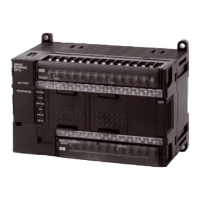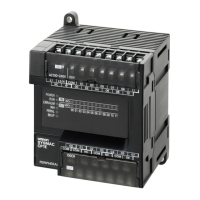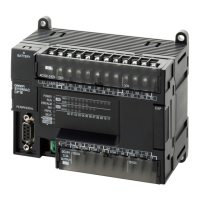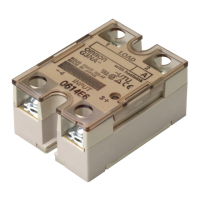301
Inverter Positioning Section 5-3
Output Coefficient during
Acceleration and
Constant Speed
Output Coefficient during
Deceleration
Setting Description Set value Default Application Refresh timing
Output coeffi-
cient during
acceleration
and constant
speed
Upper and lower limits are placed on
the output value by multiplying the pulse
output value by a coefficient during
internal pulse output acceleration or
constant speed.
Output Upper Limit =
Internal pulse output value + Internal
pulse output value
× Output coefficient
Output Lower Limit =
Internal pulse output value − Internal
pulse output value
× Output coefficient
Note The setting is made in incre-
ments of 0.01. The coefficient will
thus be the set value times 0.01.
For example, if the set value is
10, the coefficient will be 0.1 ms.
1 to 255
(0.01 incre-
ments)
Setting 0 is
the same as
setting 6
(0.01 incre-
ments).
0: 6 (0.01
incre-
ments)
This coefficient can
be used to restrict
the output range to
prevent excessive
values, based on the
internal pulse output
value when the
motor response is
slow even if a large
error is produced.
When CPU Unit
power is turned
ON
Internal pulses
Error counter
present value
Output command
to inverter
Setting Description Set value Default Application Refresh timing
Output coefficient
during deceleration
The output value can be
changed by multiplying the
value in the error counter by
a coefficient during decelera-
tion of internal pulse output.
Output value =
Error × Error counter cycle
(s) × Gain × Coefficient
Note The setting is made in
increments of 0.01.
The coefficient will
thus be the set value
times 0.01. For exam-
ple, if the set value is
10, the coefficient will
be 0.1 ms.
1 to 255
(0.01 incre-
ments)
Setting 0 is
the same as
setting 96
(0.01 incre-
ments).
0: 96
(0.01
incre-
ments)
This coefficient can be
used to reduce the output
value when the motor
response is slow and the
target position is
exceeded when stopping.
When CPU Unit
power is turned
ON

